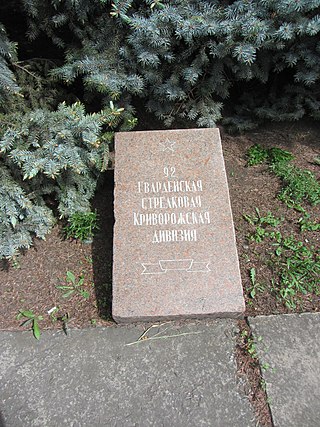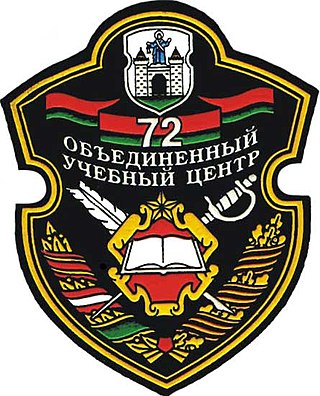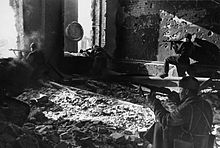
The 8th Guards Order of Lenin Combined Arms Army is an army of the Russian Ground Forces, headquartered in Novocherkassk, Rostov Oblast, within Russia′s Southern Military District, that was reinstated in 2017 as a successor to the 8th Guards Army of the Soviet Union's Red Army, which was formed during World War II and was disbanded in 1998 after being downsized into a corps. Military Unit в/ч 61877.

The 13th Guards Poltava Order of Lenin Twice Red Banner Orders of Suvorov and Kutuzov Rifle Division was an infantry division of the Red Army that was highly decorated during World War II.
The 59th Guards Kramatorsk Order of Red Banner, Order of Suvorov, Order of Bogdan Khmelnitsky Motor-Rifle Division of the Soviet Union's Red Army was initially formed near Krasnodar in March 1942 as the 197th Rifle Division. On the division's formation Colonel M. I. Zaporozhchenko took command, who stayed with the division until February 1943. Its second commander was Major-General G. P. Karamyshev from February 1943 up to the end of the war.

The 92nd Training Centre was a formation of the Ukrainian Ground Forces, that drew most of its history from the 92nd Guards Rifle Division, that became the 92nd Guards Training Motor Rifle Division in 1965.
The 79th Guards Rifle Division was an infantry division of the Red Army during World War II.

The 25th Guards Rifle Division 'Chapayevskaya' was a division of the Soviet Red Army. The division was reorganised and reformed several times until the collapse of the Soviet Union, when it entered service in the Ukrainian Army as the 25th Mechanised Division.
The 1st Guards Zvenigorod–Bucharest Red Banner Order of Suvorov Airborne Division was a division of the Soviet Airborne Troops. The division was first formed in December 1942 and fought in the Battle of the Dnieper, the Battle of the Korsun–Cherkassy Pocket, the Uman–Botoșani offensive, the second Jassy–Kishinev offensive, the Battle of Debrecen, the siege of Budapest and the Prague offensive. In August 1945 it was sent east and fought in the Soviet invasion of Manchuria. The division became the 124th Guards Rifle Division in November 1945 and disbanded in 1956.
The 70th Guards Rifle Division was formed as an elite infantry division of the Red Army in February, 1943, based on the 1st formation of the 138th Rifle Division in recognition of that division's actions during the battle, and served in that role until well after the end of the Great Patriotic War.

The 35th Guards Rifle Division was a division of the Soviet Red Army in World War II.
The 37th Guards "Rechitsa" Rifle Division was an infantry division of the Red Army which fought during World War II.

The 72nd Guards Joint Training Centre is a training centre of the Belarus Armed Forces. It trains warrant officers and junior specialists for the Belarus Armed Forces and is based in Borisov. The centre is currently led by Colonel Igor Korol. The 72nd Guards Joint Training Centre traces its history back to the Soviet 120th Rifle Division. For its actions during the Yelnya Offensive, the division became the 6th Guards Rifle Division in September 1941. In November 1945, the division became the 15th Guards Mechanized Division. On 15 May 1957, it became the 47th Guards Tank Division. The division became a training unit in 1960 and was renamed the 45th Guards Tank Training Division in 1965. In 1987, it became the 72nd Guards District Training Centre. In 1992, it was taken over by Belarus and became the 72nd Guards Joint Training Centre.
The 82nd Guards Rifle Division was reformed as an elite infantry division of the Red Army in March 1943, based on the 2nd formation of the 321st Rifle Division, and served in that role until after the end of the Great Patriotic War, including briefly in the Soviet Army.

The 4th Guards Anti-Aircraft Artillery Division was an anti-aircraft artillery division of the Soviet Union's Red Army during World War II and the Soviet Army during the early years of the Cold War.
The 42nd Guards Priluki Order of Lenin Red Banner Order of Bogdan Khmelnitsky Tank Division was an armoured division of the Soviet Ground Forces, active from 1957 to 1990.
The 36th Guards Rifle Division was a Guards infantry division of the Red Army during World War II. It was formed from the 9th Airborne Corps in August 1942 as a result of the Soviet need for troops to fight in the Battle of Stalingrad. The division was awarded the honorific Verkhnedneprovsk for its crossing of the Dnieper in September 1943 near that town, later receiving the Order of the Red Banner and the Order of Suvorov, 2nd class, for its actions in the Uman–Botoșani Offensive in March 1944. It fought in the siege of Budapest during late 1944 and early 1945, receiving the Order of Kutuzov, 2nd class, for its actions. In late 1945, it was converted into the 24th Guards Mechanized Division. Stationed in Romania, it was disbanded in early 1947.
The 50th Guards Rifle Division was an elite infantry division of the Red Army during World War II that continued as part of the Soviet Army during the early period of the Cold War. Converted into the 50th Guards Motor Rifle Division in the late 1950s, the division was based in Brest, Belarus. After the dissolution of the Soviet Union, the division became part of the Belarusian Ground Forces and was reduced to a brigade and then a storage base before being disbanded in 2006.

Vasily Pavlovich Sokolov was a Soviet Army major general and a Hero of the Soviet Union.
The 88th Guards Rifle Division was reformed as an elite infantry division of the Red Army in April 1943, based on the 1st formation of the 99th Rifle Division, and served in that role until after the end of the Great Patriotic War. It would become one of the most highly decorated rifle divisions of the Red Army.
The 129th Guards Rifle Division was formed as an elite infantry division of the Red Army in October 1943, based on the 1st formation of the 176th Rifle Division. It was the highest-numbered Guards division designated by the Red Army, although not the last to be formed.
The 214th Rifle Division was an infantry division of the Red Army, originally formed in the months just before the start of the German invasion, based on the shtat of September 13, 1939. It was moved to the fighting front to join 22nd Army in late June and took part in the fighting between Vitebsk and Nevel in early July, escaping from encirclement in the process, and then played a significant role in the liberation of Velikiye Luki, the first Soviet city to be retaken from the invading armies. In October it was again encircled near Vyasma during Operation Typhoon and was soon destroyed.













